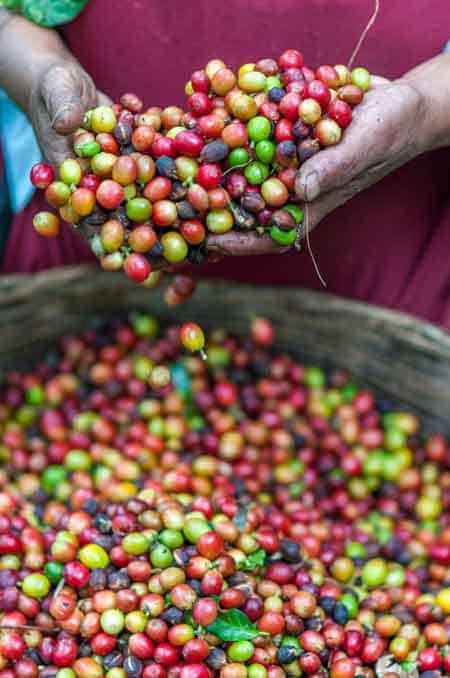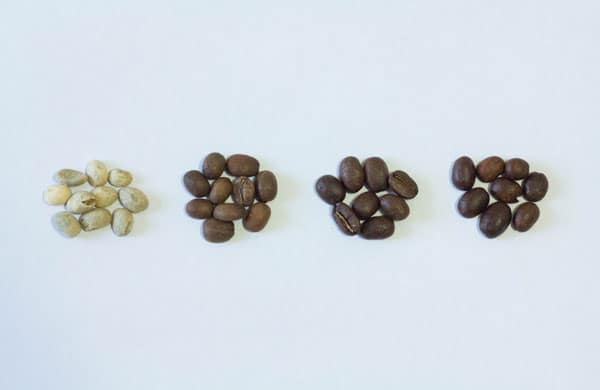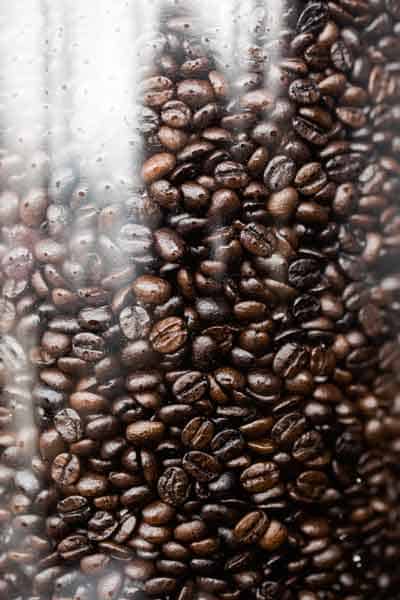Coffee aficionados in the US have recently begun to prefer roasting their own coffee. It’s a common practice in Europe that is catching on fast here. There are many reasons, ranging from people preferring to rely on being able to roast coffee to their precise preferences, to cost and convenience. If you are ready to start down the path, let’s consider how to proceed.
How To Choose The Best Coffee Beans
The best coffee beans for you will usually depend on where you want to end up in terms of the body, flavor, and aroma of your coffee. But let’s first set some expectations.
What Color Should Non-Roasted Coffee Beans Be?

To start with, let’s discuss what you should be expecting to see when you look for raw coffee beans. The beans are not brown – the browning occurs after roasting. Coffee plants are shrubs that grow at higher altitudes.
When harvested, coffee cherries (aka the fruits that grow on the coffee plants, of which the beans are a seed) are red or yellow. When husked, the beans themselves range from grayish to yellowish-green.
How the greens react to roasting is a matter of a number of factors, starting with the types of beans you use.
Types of Green Coffee Beans
The types of beans you choose depend on your taste and the type of coffee you like. There are four types of coffee beans, though only two of them (Arabica _and _Robusto) are found in the market with any consistency. Here are the main differences:
- Arabica beans account for roughly 65-70% of world coffee sales, they are certainly the predominant variety of beans sold in North America. Arabica is grown in higher elevations in moist rainforest environments within tropical or subtropical zones – many parts of South and Central America, such as Brazil and Guatemala, are home to premium Arabica beans. They produce a full-bodied sweeter, darker coffee is roasted longer, lending themselves to a premier medium-dark to dark roast, though they may have less caffeine than the Robusta beans.
- Robusta beans are more plentiful, hence cheaper, than Arabica. They tend to have more caffeine content, but coffee made primarily from Robusta beans tends to be harsher in taste – which makes them not a favorite of coffee drinkers who focus primarily on body and texture.
- Two other species, the Liberica and the Excelsa are only found sparingly – mainly grown in East and South East Asia. They are premium beans, just not widely available except in small batches.
For the purposes of our discussion, it makes more sense to focus on Arabica or Robusta coffee beans. A simple hot, fresh brew may be an Arabica bean from Ethiopia, Jamaica, Java or Guatemala – providing the body, flavor and sweetness without complications. But someone else may want to get creative. One twist may be proportionality and price. It is not uncommon to see coffee drinkers mix 3 to 4 parts Robusta to 1-part Arabica. This may end up producing a darker, heavier brew while retaining the high caffeine content and brightness usually associated with Robusta beans.
Without getting into the gory details, its relatively easy to figure out which beans you want to buy depending on the body, brightness and aroma you want out of the ultimate brew.
Finer Points Of Coffee Beans
There are other, finer points of choosing coffee beans. For example, many people prefer single-origin, small-batch coffee – given that certain varietals (species) may be developed by growers that provide a unique taste. Many prefer shade-grown coffee from high altitudes, that may have the sweetest, fruitiest flavors due to the slow maturation with a high concentration of sugars and other elements in the plant growing in adverse climates. Coffee grown in volcanic soils typically have richer, more chocolaty flavor. All of these choices can be factored in when you choose your beans.
Preparation For Roasting Coffee Beans In The Oven
When roasting coffee beans in the oven, it is important to understand a few things:
How Do Coffee Beans React to Roasting?
As described above, green coffee beans will turn increasingly darker shades of brown as you roast them. In general, be aware that there are two “pops” or cracks – the first one happens when the thin papery shell around the core of the bean bursts open, the second occurs when oils begin to migrate from within the beans. To ensure you hit your roasting target, you must start paying attention from the time you hear the first pop.
In the section on the “level of roast” below, notice how the pops come into play.

What are You Trying to Achieve?
If you are trying to roast coffee at home, you probably have a specific level of fullness, taste, and flavor in mind. We will go into the major variables below, but this is an important consideration for how long you want the beans to roast, as well as which beans you have chosen.
The choice of coffees has been discussed above, now we will talk about the length of time you want to roast the green beans. With every minute that passes, the roast gets darker and darker … and the taste and flavor changes.
In general, you can characterize coffee by its BODY and ACIDITY. The degree of roasting affects both of these. BODY refers to how your tongue feels when the sip of coffee first hits it – a “full-bodied” coffee is one that retains most of its flavor and taste, feeling rich and heavy on the tongue; while a “lighter-bodied” coffee feels more watery, with little or no residual taste left on your tongue. ACIDITY is also known as brightness – it’s the feeling of tanginess or other sharpness that flows across your tongue when you drink coffee.

Darker (longer) Roast Coffees have more body and less acidity, while Lighter Roasts do the reverse. It may also be relevant to consider the caffeine content – lighter roasts have slightly more caffeine than the darker varieties. It’s up to you to choose what you prefer and roast accordingly. Let’s see how coffee behaves on the gamut from Light Roast to Dark Roast:
- Light Roast: Light roasting requires temperatures between 356°F and 401°F. This level is achieved after a few minutes, as soon as the first “pop” is heard – some beans may even remain uncracked. The beans will typically be dry and orange-brown in color, with no visible oils showing. The coffee will be higher in acidity and lighter in body. While it may taste harsh by comparison, some prefer light roast coffee due to the level of anti-oxidants that remain. Light Roasts are also known as Blonde, New England, Half City, Light City, or Cinnamon.
- Medium Roast: Medium roasting requires temperatures between 410°F and 428°F. This level is achieved a few minutes after the first “pop” is heard – but well before the second pop. The beans will be medium-brown in color and still tend to dryness. The coffee will be higher in acidity and lighter in body. Medium Roast will taste sweeter, with more balanced acidity, aroma, and flavor, compared to the Light Roast. They are also known as American, Breakfast, City, City Plus, or Regular.
- Medium-Dark Roast: Medium-Dark roasting requires temperatures between 437°F and 446°F. This level is achieved more than a few minutes after the first “pop” is heard – very close to the second pop. The beans will be dark in color and appear shiny as oils begin to appear. The coffee will have less acidity and a fuller body with abundant aromas, somewhat akin to how you experience fine, dry wine. Medium-Dark Roasts are also known as Vienne Vienna, Full City, Full City Plus, or European, Continental, or After Dinner.
- Dark Roast: Dark roasting requires temperatures between 464oF and 482oF. This level is achieved at or right after the second “pop” – you should take care since beans tend to turn towards blackening very quickly once the second pop happens. The beans will typically be oily and close to charcoal black in color. The coffee will be lower in acidity and fuller in body, with a sweet and smoky taste. Dark Roasts are also known as French, Italian, Turkish, Spanish, Neapolitan, New Orleans, High or Double.
Where you end up on the spectrum depends upon your taste, but if you are going for home roasting options, you are probably enough of a coffee aficionado to have a clear idea about the type of coffee roast you prefer.
So now we’re ready. Next steps are to prepare the oven, the pan and get to the step by step instructions about how to get the roasting process started.
Oven Roasting Coffee Beans – Step-By-Step Instructions
A standardized process to oven roast coffee is outlined below. Notice that the intention is to produce a darker roast (somewhere between Medium-Dark to a Dark). If you want a lighter roast, adjust the oven setting accordingly. There are four basic steps:
Step 1 – Choose the Right Coffee Beans
Choose the green coffee beans that best suit your taste, per the guidelines discussed previously – it could be Brazilian, Jamaican, Java or anything else, it’s up to you.
Step 2 – Preheat the Oven, Prepare the Pan, Have a Spatula and Metal Colander Ready
Preheat the oven to 450°F (232°C). While its warming up, prepare the pan for roasting. You want to use a perforated metal sheet (readily available at stores) – though the holes should not be big enough for the coffee beans to fall through.
Pour the beans onto the sheet, taking care to arrange them close to each other, but with the minimum amount of overlap, then put them in the oven once it has reached its target temperature. Also, you want to have two other implements ready: a spatula and one (or two) metal colanders.
Step 3 – Roast to the Desired State
The beans will start to pop, as discussed, after a few minutes (could be between five to nine minutes depending on the type of beans). Keep a close watch, since beans darken fast once they get past the first pop. Use the spatula to move the beans around the sheet to ensure a more even roast. When you stop the roast will depend on where on the “Light to Dark Roast spectrum” you want to be. Typically, you should expect a medium-dark to dark roast to occur after 10 to 15 minutes. Once you reach the desired state, pull out the heating pan.
Step 4 – Let the Beans Cool
Once the beans are taken out, be aware that they will continue to roast as they cool. You could help the process by moving them around in the colander. If you have two colanders available, pouring them from one to the other will also help – the beans will cool faster while their outer skins will peel off faster. Wait till the beans feel cool. DO NOT put them in a refrigerator since that will cause moisture to build up. On a side note, make sure the husks are not present in the roasted beans.
Step 5 (Optional) – Store and Wait for 24 Hours Before Brewing?
Once the beans are cool, store them in a tightly sealed jar. They should be good to go – though it may be optimal to wait for 24 hours before brewing the coffee.
Variations of the above steps can be considered based on the degree of roasting, the type of beans you choose and other considerations. But you get the basic idea.
Alternative Methods To Roasting Coffee Beans At Home
There are a number of other ways to roast coffee at home, if you want to consider alternatives to an oven. A few common ones are mentioned below.
Using an Iron Skillet
An iron skillet may be the simplest way to roast coffee beans, except that you will lose a significant amount of flavor due to the open-top method of roasting. The basic principle is the same as an oven. Separate the beans as much as possible on a cast-iron skillet, listen for first pop and closely watch the color as it browns. Once you reach the desired roast, pour onto a colander and allow the beans to cool before bottling them up.
Re-purpose a Popcorn Popper
A popcorn popper can definitely be used to roast coffee beans. There are a number of popular brands such as Whirley-Pop Popcorn Popper. To start with, you should not load more than 8 oz of coffee beans at a time. The beans can be observed while roasting since half of the Whirley-Pop lid is hinged and flips up. Also, the popping is easy to track since there is no noise from a fan or motor.
A popcorn heater produces an effect close to drum roasting. The only drawback is that you have to pay more attention to what is going on and have to crank to spread the beans over evenly – unlike a roasting appliance or an air roaster.
Using an Air Roaster
Air Roasters work similarly to the Popcorn Poppers. Specific instructions on how to use Air Roasters to roast coffee can easily be found online based on the type of air heater you employ.
Using a Coffee Roaster
Coffee Roasters are a definite step up from Popcorn Poppers or Air Roasters – they are designed for taking in a specific quantity of beans and replicating the drum method of roasting for maximum effect in a small-scale setting. There are a wide range of roasters for all grades of users, from novices to experienced. Typical roasters include multiple speed fans to agitate the raw beans, multiple heat settings and the means to blow the husk off – for example, one of the higher end Coffee Roasters provides nine heat settings and an equivalent number of fan settings. They are a significantly costlier option than popcorn poppers but may be well worth the price. One of the key issues is smoke, the cheaper grades of coffee roasters do not have advanced smoke control – it’s something to watch out for.
Oven Roasting Coffee Beans – FAQ
There are a few commonly asked questions. A sample is provided below. The biggest questions probably revolve around whether or not it makes sense to roast your own coffee, so let’s start there. A number of other questions (e.g. what type of green beans to buy, what type of roast to shoot for) have been answered previously.
Does it Make Sense to Roast Your Own Coffee?
Here are some of the reasons that roasting your own coffee is worth the effort to a serious coffee drinker:
- Freshness: Roasted Coffee grows stale relatively fast after you procure them and open the bags – the average life (before which it starts losing flavor and aroma) is typically less than a month. Green coffee beans, on the other hand, can easily stay fresh for three to four months. You can roast them in small batches over that time and enjoy the brew without losing taste and flavor. Here’s the bottom line – if you truly value freshness, it’s tough to beat the option of roasting your own coffee, even the best varieties of coffee that are sold after being pre-roasted will have lost some freshness and flavor.
- Price: A full bag of premium green coffee is significantly cheaper than a comparable bag of a middle of the road roasted coffee. The market is such that the more the beans are processed, the more they cost. So if you are a true connoisseur, it may make sense to buy super premium, high end green coffee beans and roast them at your place. Even if you don’t use a conventional oven or a stovetop pan (i.e. if you have to invest in a coffee roaster), the fixed cost of such an appliance will be covered soon.
Is It Safe?
Yes, it’s safe. But you must watch closely, since most home roasting methods do not control for smoke emission. It’s not difficult to watch over home roasts, though, we are typically talking about a 15 to 20-minute period.
How Long Does Home Roasted Coffee Last?
Before roasting, green coffees last three to four months. However, once roasted, they should be immediately sealed in an airtight container to retain flavor and aroma. Ideally, they should be used within two to three weeks.
Is the Process Tedious or Time Consuming?
Home roasting takes no more than 15 to 20 minutes from start to finish. Moreover, things get easier to manage once you get used to the process and its nuances.
Summary
In conclusion, home roasting coffee is certainly a more involved process than just ordering ground coffee or roasted beans from your favorite retailer. However, if you are willing to take the time to process small batches, the change in freshness and taste can be quite amazing.
Europeans have led the way with home roasting, as they have in most things related to coffee – but Americans are now beginning to wake up to the possibilities of combining great taste with affordable prices.


